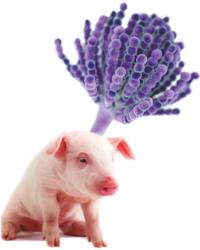Francesc Accensi
Centre de Recerca en Sanitat Animal (CReSA) Institut de Recerca i Tecnologia Agroalimentàries (IRTA), Barcelona. Departament de Sanitat i d’Anatomia Animals, Facultat de Veterinària (UAB), Barcelona
What are mycotoxins?
A mycotoxin can be produced by more than one genus or species (for example, Ochratoxin A can be produced by Aspergillus ochreaceus, A. niger or Penicillium verrucosum) and the same fungal strain can produce more than one toxin (for example, A. flavus can produce Aflatoxins and cyclopiazonic acid).
Clasification of mycotoxins
FIELD MYCOTOXINS
Mycotoxins produced throughout the plant’s life before harvest (the typical example is the case of mycotoxins produced by Fusarium spp., such as Fumonisins and Deoxynivalenol).
STORAGE MYCOTOXINS

Mycotoxins produced after harvest, during the storage of the grain (this is the case of mycotoxins produced by the genera Aspergillus or Penicillium, such as Aflatoxins or Ochratoxin A).
Over time, it was observed that, even though in general it is a valid classification, the so-called field mycotoxins can appear after harvest, during the first stages of storage. On the other hand, storage mycotoxins can also be produced during the plant’s life, during the last stages of the fruit development and before harvest.
Types of mycotoxin intoxications in pigs
The ingestion of these mycotoxins causes a kind of intoxication called mycotoxicosis.
Mycotoxin intoxication can be acute, subacute, or chronic, with the effects depending on the dosage, exposure time and, logically, the toxin involved.
DIAGNOSIS
One of the major problems regarding mycotoxicosis is establishing a clear diagnosis.
Generally, after evaluating various options, the time when mycotoxin intoxication is proposed as the problem on the farm, it is already late to definitively establish the correct diagnosis.
There are rarely any remains of the feed that was consumed by the pigs that could be associated with intoxication, which means that analyzing the presence of toxins in the feed that they are currently consuming makes no sense.
Additionally, it is important to keep in mind the importance of taking feed samples for mycotoxins detection: correct sampling at various sites and homogenization of the sample are key points for taking samples.

Table 1. Main mycotoxins that affect swine and the symptoms and lesions they produce (Osweiler & Ensley, 2012)








 Micotoxicosis prevention
Micotoxicosis prevention